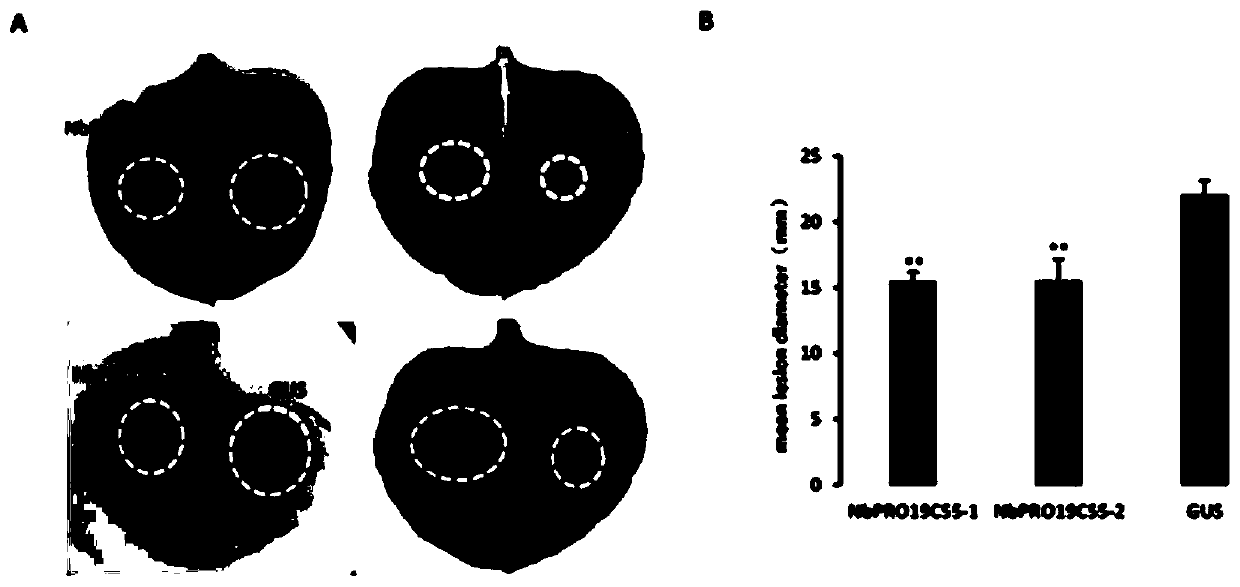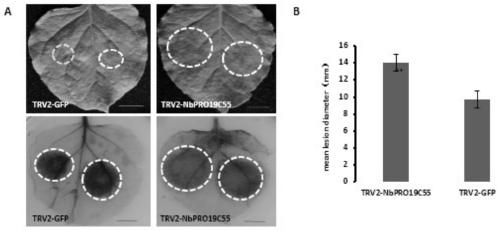Positive regulation factor NbPRO19C5-1 gene and application of protein of positive regulation factor NbPRO19C55-1 gene in plant phytophthora resistance
A positive regulation, Phytophthora technology, applied in angiosperms/flowering plants, applications, plant peptides, etc., can solve the problem of less research on small peptides, and achieve the effect of improving resistance
- Summary
- Abstract
- Description
- Claims
- Application Information
AI Technical Summary
Problems solved by technology
Method used
Image
Examples
Embodiment 1
[0027] Cloning of NbPRO19C55-1 Gene
[0028] 1. Plant material: Nicotiana benthamiana (obtained through public channels), RNA is extracted from its leaves.
[0029] Extract RNA with RNA extraction kit (OMGA, Lot#:R6827-01), identify the integrity of RNA by agarose gel electrophoresis, and then measure the purity and concentration of RNA on a spectrophotometer.
[0031] Use the reverse transcription kit (TaKaRa, Lot#:AHE3187A) to obtain the cDNA of Nicotiana benthamiana, and design the upstream and downstream primers NbPRO19C55-F / R according to the full-length coding sequence of NbPRO19C55 provided in the Solanaceae website,
[0032] NbPRO19C55-F: 5'-CGGGGTACCATGGCAAGATTTGTGGACTTT-3',
[0033] NbPRO19C55-R: 5'-CTAGACTAGTCTACTTATCATCATCATCCTTATAATCTTGATGATTGCCAGTGACAAC-3',
[0034] Amplification was performed using cDNA as a template. The PCR product was digested, ligated, and verified by bacterial liquid PCR to construct the vector pKannibal-AtPPR1,...
Embodiment 2
[0036] Sequence information and homology analysis of NbPRO19C55-1 gene
[0037] The full-length CDS sequence of Nicotiana benthamiana NbPRO19C55-1 gene of the present invention is 270bp. For the detailed sequence, see Sol GenomicsNetwork: Niben101Scf00803g01016.1, such as SEQ ID No: 1 of the present invention. The amino acid sequence has a total of 89 amino acids. For the detailed sequence, see Sol Genomics Network: Niben101Scf00803g01016 .1, such as SEQ ID No: 2 of the present invention.
[0038] The amino acid sequence of the protein encoded by the Nicotiana benthamiana NbPRO19C55-1 gene was searched for homology with the BLAST program, and it was found that its similarity with the amino acid sequence of a gene NbPRO19C55-2 in Nicotiana benthamiana was more than 90%. See Sol Genomics Network for the amino acid sequence: Niben101Scf03747g00005.1, such as SEQ ID No: 3 of the present invention. From the above, it can be inferred that a homologous gene has the same or similar f...
Embodiment 3
[0041]Example 3 NbPRO19C55-1 overexpression plants show resistance to Phytophthora parasitica
[0042] Design specific primers to detect the expression of NbPRO19C55-1 in overexpressed plants. About 0.2 g of tobacco leaf samples were collected to extract RNA and reverse transcribed into cDNA, then specific primers were designed to detect the expression of NbPRO19C55-1 by real-time fluorescent quantitative PCR technology. Collect common smoke safflower Dajinyuan with a seedling age of 6-7 weeks as a control, inoculate GFP-labeled Phytophthora parasitica mycelia blocks after scratching the leaves, and observe and measure the disease after cultivating in the dark at 23°C for about 48 hours. spot diameter. The result is as figure 2 shown.
PUM
 Login to View More
Login to View More Abstract
Description
Claims
Application Information
 Login to View More
Login to View More - R&D
- Intellectual Property
- Life Sciences
- Materials
- Tech Scout
- Unparalleled Data Quality
- Higher Quality Content
- 60% Fewer Hallucinations
Browse by: Latest US Patents, China's latest patents, Technical Efficacy Thesaurus, Application Domain, Technology Topic, Popular Technical Reports.
© 2025 PatSnap. All rights reserved.Legal|Privacy policy|Modern Slavery Act Transparency Statement|Sitemap|About US| Contact US: help@patsnap.com



